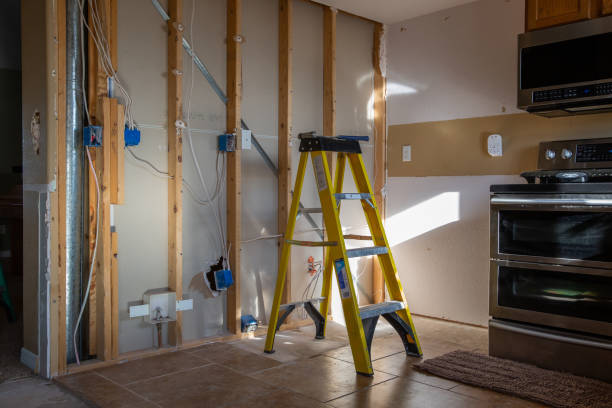
Taping and mudding drywall is an essential step in achieving a smooth and seamless finish for your walls. Here’s a step-by-step guide on how to tape and mud drywall:
Materials you’ll need:
- Drywall tape (paper or mesh)
- Joint compound (mud)
- Putty knife
- Drywall mud pan
- Sandpaper (various grits)
- Sanding block or pole sander
- Water
- Sponge or damp cloth
Step 1: Prepare the drywall joints
- Ensure that the drywall panels are properly installed, with no gaps between them.
- Use a utility knife to cut away any protruding or damaged drywall paper edges.
- Apply a thin layer of joint compound over the joints and screw/nail indentations (known as dimples) using a putty knife. This is called the “first coat” or “bed coat.”
Step 2: Apply drywall tape
- Cut pieces of drywall tape slightly longer than the joints you’re working on.
- Press the tape firmly onto the joint compound while it’s still wet, aligning it along the center of the joint.
- Smooth out any bubbles or wrinkles in the tape using your putty knife, ensuring good adhesion to the joint compound.
Step 3: Second coat application
- Apply a second coat of joint compound over the tape using a wider putty knife than the first coat.
- Extend the mud beyond the edges of the tape, feathering the edges to create a gradual transition.
- Smooth the joint compound as much as possible, aiming for a flat surface. However, it doesn’t need to be perfect at this stage.
Step 4: Third coat application
- After the second coat has dried (usually overnight), lightly sand any ridges, bumps, or imperfections with sandpaper.
- Apply a third coat of joint compound, wider than the previous coats.
- Feather the edges further out to blend the compound into the surrounding area.
- Again, allow the mud to dry completely.
Step 5: Finishing touches
- Once the third coat is dry, sand the area using fine-grit sandpaper to achieve a smooth and even finish.
- Wipe away any dust with a damp sponge or cloth, and let the wall dry.
- Inspect the surface for any remaining imperfections and apply additional coats of joint compound as needed, repeating the sanding process between coats.
Step 6: Final sanding and touch-ups
- Sand the area one last time using fine-grit sandpaper, focusing on achieving a seamless transition between the joint compound and the surrounding drywall.
- Wipe away any dust and check for any visible seams or imperfections.
- If necessary, apply a thin layer of joint compound to smooth out any remaining flaws.
- Sand and touch up the area as needed until you achieve the desired smoothness and seamless finish.
Remember, patience and attention to detail are key when taping and mudding drywall. It may take several coats and sanding iterations to achieve a professional result. With practice, you’ll develop the skills to create smooth and seamless walls ready for painting or finishing.
.

